New 1/35 scale WWII armor kits from Tamiya:
Finnish Sturmgeschütz III (StuG III) Ausf. G “Sturmi”
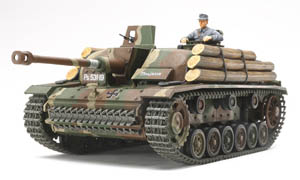
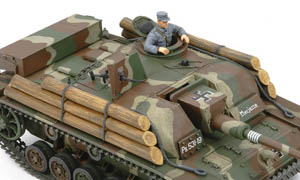
German Panzerkampfwagen 35(t)
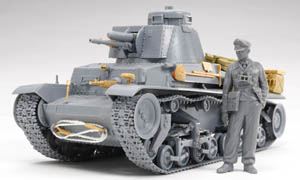
New 1/35 scale WWII armor kits from Tamiya:
Finnish Sturmgeschütz III (StuG III) Ausf. G “Sturmi”


German Panzerkampfwagen 35(t)

An M4 Sherman tank and crew of the 3rd Tank Battalion, 10th Armored Division await engine repair during training at Camp Gordon in Georgia. The 10th Armored (“Tiger”) Division was activated at Fort Benning, Georgia in July 1942, participated in the Tennessee maneuvers, and then moved to Camp Gordon, Georgia for further training. [Source: LoneSentry.com Collection.]
Summary of naval terminology from FM 30-50: Recognition Pictorial Manual of Naval Vessels, U.S. Navy Department, September 1943:
TERMINOLOGY
ABAFT _ _ _ behind; toward stern from.
ABEAM _ _ _ at right angles to the keel.
AMIDSHIPS _ _ _ the middle portion of a vessel.
ARMOR _ _ _ steel plating designed to defeat shells, bombs, or underwater explosion.
ARMOR BELT _ _ _ band of armor extending along a ship’s sides above and below water-line.
ATHWART _ _ _ across; from side to side; traversly.
BEAM _ _ _ extreme width of ship.
BILGE _ _ _ curved part of ship’s hall where sides and flat bottom meet.
BLISTER _ _ _ a bulge built into a ship’s side as a protection against torpedoes.
BOOM _ _ _ a free-swinging spar used to secure boats or to handle cargo, boats or aircraft.
BREAK _ _ _ the point at which upper decks are discontinued.
BRIDGE _ _ _ raised forward platform from which ship is conned and navigated.
BULKHEAD _ _ _ transverse or longitudinal partitions subdividing the interior of a ship.
BULWARKS _ _ _ light plating or wooden extension of ship’s sides above upper deck.
CASEMATE _ _ _ armored gun mount built into the sides or superstructure of a ship.
CLASS _ _ _ vessels of the same type built to a common basic design.
COMBINED OPERATIONS _ _ _ joint operations conducted by nonhomogeneous forces or forces of different services and/or nationalities.
COMPANIONWAY _ _ _ hatchway providing access from one deck to another.
COMPARTMENTATION _ _ _ subdivision of a ship’s hull by means of transverse and/or longitudinal bulkheads.
CONNING TOWER _ _ _ armored ship control station. In submarines, the main deck structure.
COUNTER _ _ _ side of a vessel’s quarter.
COWL _ _ _ a smoke baffle located on top of a funnel; opening of a ventilator.
DAMAGE CONTROL _ _ _ comprehensive term for all means of mitigating or offsetting effects of damage aboard ship.
DEPTH CHARGE _ _ _ explosive device projected or dropped from air or surface craft; detonated at predetermined depths by a hydrostatic mechanism.
DISPLACEMENT _ _ _ the weight of water displaced by a ship.
FANTAIL _ _ _ after section of the main deck.
FORE _ _ _ that part of a ship lying between bow and midship section.
FORE AND AFT _ _ _ lengthwise of a ship.
FORECASTLE _ _ _ deck; a forward upper deck extending to bow.
FREEBOARD _ _ _ height of a ship’s sides from waterline to a weather deck.
FLYING BRIDGE _ _ _ a light self-supporting structure extruding from side of ship’s bridge.
GUN HOUSE _ _ _ a lightly protected, rotating mount for guns of lesser calibre.
GUN SHIELD _ _ _ any protection for gun crews which does not completely enclose mouut.
GUNWALE _ _ _ upper edge of a vessel’s or boat’s side.
HALYARDS _ _ _ light lines used in hoisting signals, flags, etc.
HATCH _ _ _ opening in a deck.
HAWSE PIPES _ _ _ tubes leading anchor chains from deck down and forward through bow plating.
HELM _ _ _ the mechanism for operating the ship’s rudder.
HULL _ _ _ main body of a vessel exclusive of elements of superstructure.
ISLAND _ _ _ a free-standing section of a ship’s superstructure. On aircraft carriers, the ship’s superstructure.
KEEL _ _ _ center line strength member running fore and aft along the bottom of a ship.
KNOT _ _ _ a unit of speed, equalling one nautical mile (6,080.20 feet) per hour.
LIST _ _ _ traverse inclination of a vessel.
MAIN BATTERY _ _ _ the heaviest calibre gun armament carried by a naval vessel.
MAIN DECK _ _ _ a ship’s highest continuous deck.
MINE _ _ _ a device containing high explosive charge, free-floating or anchored at fixed depth, or resting on bottom; detonated by contact, or by electrical or magnetic impulse.
MULTIPLE MAST _ _ _ an exposed mast having one or more supporting elements.
PEAK (fore and aft) _ _ _ compartment at the extreme bow or stern of vessel below decks—usually a tank.
PORT _ _ _ left hand side of a vessel when looking towards bow; an opening.
QUARTER _ _ _ that portion of a vessel’s side near the stern.
QUARTER DECK _ _ _ part of upper deck reserved for officers; also the deck near the stern.
RADIO DIRECTION FINDER _ _ _ device for determining direction of source of radio impulses.
RAKE _ _ _ fore and aft inclination from vertical.
RANGEFINDER _ _ _ optical instrument for determining distance to a target or other object.
RECIPROCATING ENGINE _ _ _ a steam actuated piston engine as distinguished from a turbine.
RIGGING _ _ _ collective term for ropes and chains employed to support masts, yards, and booms of vessel.
SECONDARY BATTERY _ _ _ the gun armament next in calibre to main battery.
SHEER _ _ _ longitudinal upward or downward curvature of deck or gunwale.
SHEER LINE _ _ _ line formed by intersection of deck and sides of a ship.
SPLINTER SCREEN _ _ _ light armor shields for protection of crew.
STACK _ _ _ exposed uptake from ship’s boilers; funnel.
STARBOARD _ _ _ the right hand side of a vessel when looking towards bow.
STEM _ _ _ extreme forward line of bow.
STERN POST _ _ _ the main vertical post in the stern frame upon which the rudder is hung.
SUPERSTRUCTURE _ _ _ any structure built above a ship’s hull.
TASK FORCE _ _ _ a naval force organized to carry out a specific mission.
TURRET _ _ _ a rotating mount enclosed by armor for guns of large calibre.
TWIN TURRET _ _ _ a turret housing two guns.
TYPE _ _ _ all vessels built or converted for the same purpose.
WEATHER DECK _ _ _ any deck exposed to weather.
WELL _ _ _ a lateral opening in a ship’s hull or superstructure.
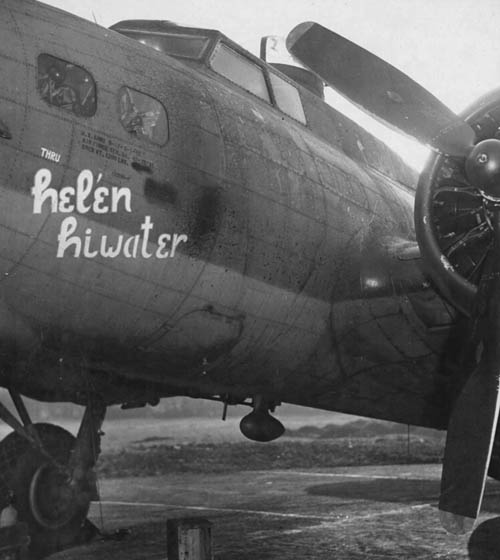
U.S. Air Force Photo
B-17G Thru Hel’en Hiwater was assigned to the 358th Bombardment Squadron, 303rd Bombardment Group (“Hell’s Angels”). The B-17 was lost, along with the 2Lt. Roy A. Larson and crew, during a mission to Hamm, Germany in April 1944. Thru Hel’en Hiwater was infamous for buzzing Yankee Stadium during the opening game of the 1943 New York Yankee vs St. Louis Cardinal World Series piloted by 2Lt. Jack W. Watson.
Upcoming fall and winter 2010 “In Detail” books from Wings and Wheels Publications covering WWII vehicles, trains, and aircraft.
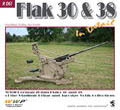 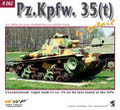 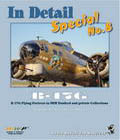 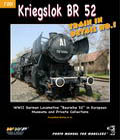 |
Red Museum Line
Special Line
Train Line
|
The August 1943 issue of NEWSMAP stressed the importance of accurate tank recognition. Learn to recognize one vehicle from another as instantly as you know “Bill” from “Ed” or a Chevrolet from a Ford. Practice on every vehicle you see and on every picture of one in magazines, newspapers, or newsreels.
Failure to recognize destroyed our own tank… and also cost us a vehicle and crew!
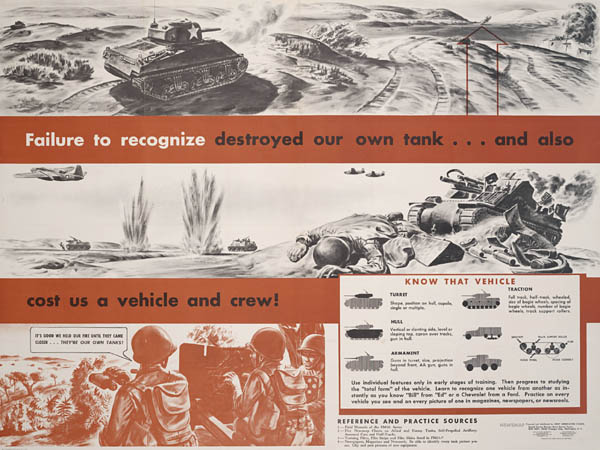
Know That Vehicle:
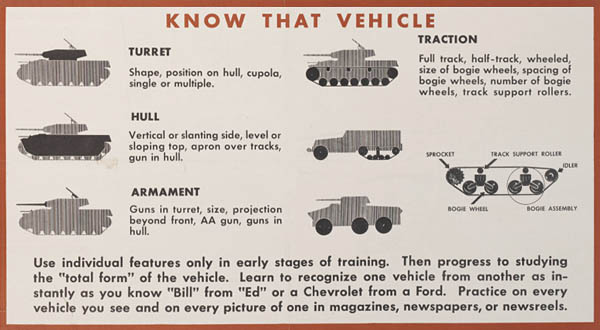
Source: NEWSMAP, August 2, 1943, Army Information Branch.
The Library of Congress explores the evolution of “Rosie the Riveter” and describes the lives of real women workers on the U.S. Home Front in World War II.
Rosie the Riveter – Real Women Workers in World War II:
The documentary is narrated by Sheridan Harvey. Sheridan Harvey is a Women’s Studies Specialist in the Humanities and Social Sciences Division. She is also the editor of “American Women” which is a guide for the study of women’s history and culture in the U.S.
Aircraft Insignia poster prepared and distributed by Army Orientation Course, Special Service Division, Army Service Forces, U.S. War Department, 1943.
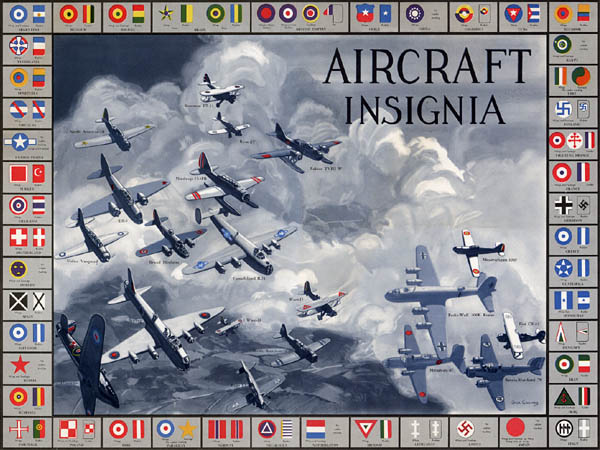
The following U.S. intelligence reports on Japanese suicide boats were published in Enemy on Luzon: An Intelligence Summary:
NAVY SUICIDE CRASH BOATS:
Japanese suicide crash boats manned by Naval personnel were found in a tunnel on Corregidor. The boats were loaded on small carts which were mounted on rails running from the tunnel to the beach where they were to be launched.
The Navy Suicide Crash Boat was 16 feet 8 inches long and had a beam of 5 feet 8 inches. The hull was plywood construction throughout and was powered by an automotive type, 6-cylinder, in-line, gasoline engine. The explosive charge was built into the hull of the boat. This last feature was the main difference between the Army and Navy suicide boats.
The Type 98 explosive charge weighed 640 pounds and was located below the deck forward of the cockpit. The charge could be fired by three methods: 1) electrically on impact; 2) electrically by closing a switch; and 3) by use of a pull igniter.
From the disposal point of view, the boat was dangerous to anyone unfamiliar with the circuit and switch details. It would also have been simple to rig this boat as a booby trap either electrically or through the pull igniter.
The boat carried a big charge that would be effective against ships. The only defense that a ship had was, as in the case of the suicide plane, accurate gunfire.
ARMY SUICIDE CRASH BOAT:
Japanese suicide boats, to be manned by Army personnel, were recovered at Lingayen Gulf, Luzon. These craft were the principal weapon of the Japanese Gyoro (“fishing”) battalions.
The army suicide boat was made of plywood with a length of 18½ feet and a beam of 5 feet 10 inches. It was decked with a forward hatch leading to the engine and has a cockpit aft. The boat was powered with a 6-cylinder Chevrolet automotive engine, about 85 horsepower. The maximum speed of the craft was estimated at 35 knots. The fuel capacity was about 56 gallons.
The two 120 kg depth charges were mounted on racks abreast of the cockpit. The charges could be either dropped close aboard or released when the boat crashed into the ship. At least one attack of the former type was made, resulting in damage to a merchant ship during the Luzon campaign.
Although parts of the release mechanism were not available, the operation is believed to have been as follows: the charges were fitted in the racks and held by an arrangement of slings and bars. Rods fitted to extend beyond the bow would be driven back releasing the charges during a collision with another ship. However, the coxwain could place a crossbar forward to release the charges.
German rail transport destroyed by Allied bombing raids in the railyards at Littorio, Italy. In an unusual combination, the Germans loaded a small car in the back of a truck which was then loaded in the railcar in the foreground.
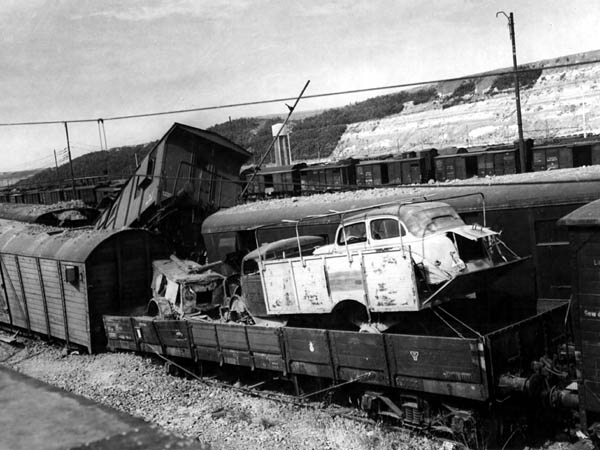
U.S. Air Force Photograph.